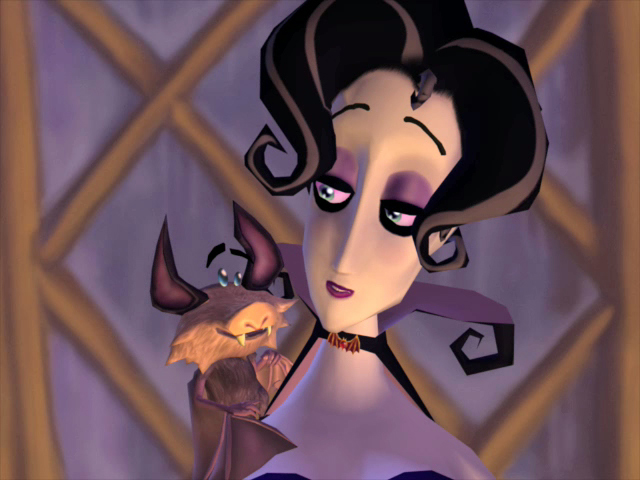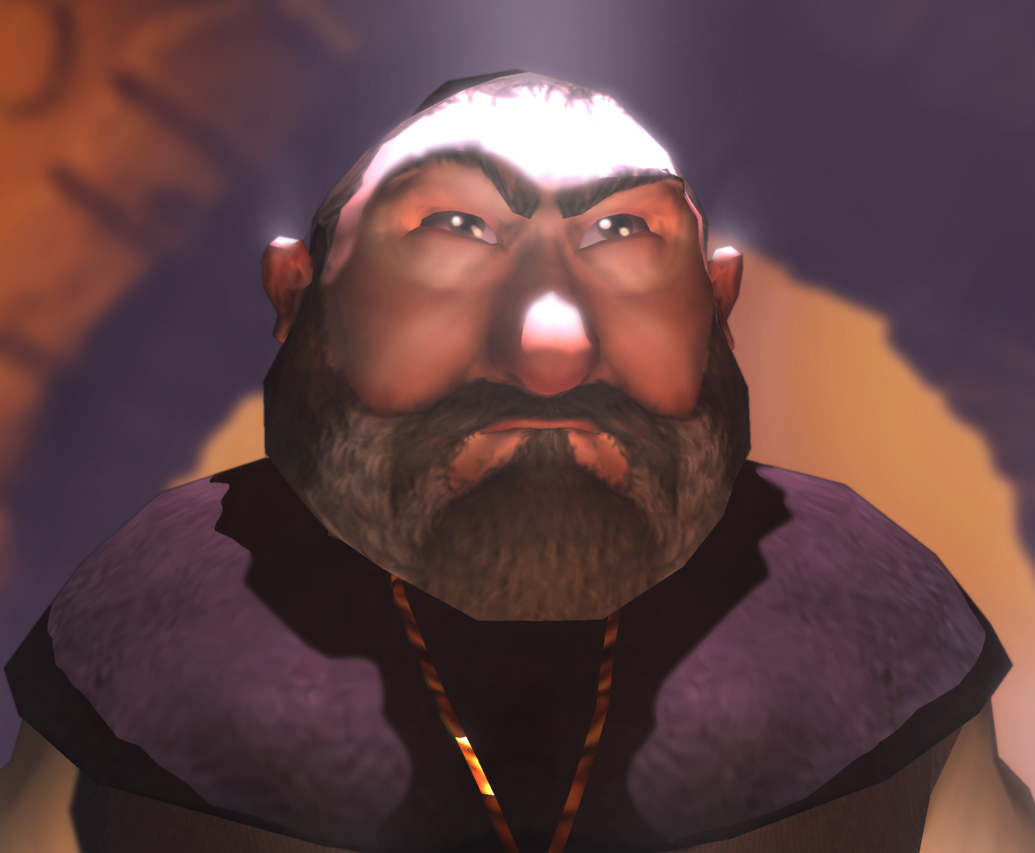Articles

A Vampyre Story Page Two
Mona’s companion Froderick is also a sort of mechanic, though one you have seen before. Perched perpetually on Mona’s shoulder, he is basically a marginally more sane version of Max from Sam & Max Hit the Road – his primary function is to supply sarcastic comments and to be used as an inventory item should a puzzle call for his assistance. He's also Mona's friend and mentor in the process of accepting her vampire form, and in this capacity serves as a source of exposition as much as one of comic relief. And there's quite a bit of that. Despite the macabre subject matter and gloomy settings, this is a very lighthearted game reminiscent of a Disney film; or, if you prefer, it’s like Monkey Island but with vampires instead of pirates. Although there are dark, dramatic moments, the game is very much a comedy, and strives for the kind of the humor the LEC games were famous for. And there are plenty of in-jokes and references, which never fail to amuse.

Unfortunately, the humor falls flat consistently if not exclusively. The game is constantly trying to be funny, but the laughs are not generated with the effortlessness that was so characteristic of LEC’s best work. There’s an unpleasant forcefulness to far too many of the jokes that makes the game come off as desperate to make the player laugh; every line wants to be a punchline. Part of the problem is that the dialog has a tendency to be overwritten. To be sure, verbosity is a trademark of Sam & Max and the later Monkey Island games, but the dialog here does not crackle with the wit those games were known for. There are too many occasions when the game itself doesn’t even seem to trust that it’s funny, because it goes as far as to explain its jokes, which is devastating. Consider the following exchange, which occurs when Mona and Froderick are investigating instruments of torture in the castle dungeon:
Mona: I don't want to touch that thing. It's got lots of … residue on it.
Froderick: You're right, Mona. It looks like there are bits of flesh and bone … and maybe a few coffee beans.
Mona: Coffee beans?
Froderick: Yes, Shrowdy sometimes liked to start his day with a hot cup of Joe and the evening paper boy.
Mona: Don't you mean the evening paper?
Froderick: No, I mean the paperboy. Shrowdy always enjoyed feasting on Draxsylvanian paper boys. I assume he threw their corpses into the pit, then climbed into his coffin where he'd relax and read their papers.
If this conversation would have ended after the fourth line, it would have earned a chuckle from me, but instead it insists on pounding the joke home, thus ruining it. And the above exchange is no outlier – too many potentially funny moments self-destruct because the game doesn’t know when to close the valve. There’s a lack of confidence in the writing that really hurts, though does not collapse, what is otherwise such an engrossing game. There is funny material, to be sure (especially when we check in with Monsignor Calvin, the determined, sidekick equipped vampire hunter whose all too infrequent bits were among my favorites), but the game’s world is too finely crafted, its characters too endearing, and the presentation otherwise way too strong for the script’s weaknesses to do anything but stick out like a sore thumb.
Although the humor is the biggest casualty, the ponderous nature of the dialog also harms some of the exposition - there are occasions where information is delivered in awkwardly concentrated bursts instead of conveyed in more effective ways. There’s a lengthy pre-rendered cutscene (and I don’t know why it’s pre-rendered as nothing particularly cinematic happens during it) in the middle of the game in which a fortune teller named Madam Strigoi literally assigns Mona a bunch of tasks in such a point-blank way that it feels like she’s reading an objective list straight from the design document. What makes such a scene a tad ridiculous is the contrast that it represents with the game’s instances of truly deft storytelling. The opening cutscene, which in the span of a few minutes hurls us right into the proceedings, sets the tone, and introduces us to several characters while ladling out just enough backstory in a way that isn’t overwhelming and is as visual as it spoken (including a fantastic little storybook depiction of Mona’s life leading up to Castle Warg during the credits), is as brilliantly handled as any game opening I can think of.

To many, the puzzles of an adventure game are as important as the narrative. At their best, they should feel organically woven into the story, which is largely the case here. Yet unless it’s particularly amazing or terrible, puzzle design is a difficult thing to critique since gamers themselves are so split about what constitutes good versus bad in this area. I found that the faithfulness with which A Vampyre Story captures the spirit of ´90s adventures extends to its approach to puzzles, which for my tastes could get a bit obtuse and perhaps too casually reliant on backtracking, but were nonetheless clever and enjoyable to solve. The fact that a number of reactions to the game that I’ve read have excoriated its easiness only hammers home the subjective nature of adventure game puzzles. While I had my moments of hair-pulling, it’s my take that the game’s moments of frustration are way outnumbered by the fun you’ll have between them (or even during them – no one who signs up for an adventure game isn’t a masochist at some level). I also have to commend the game’s elimination of unnecessary pixel hunting by borrowing a feature seen in Grim Fandango (and other games, I’m sure) - holding down the Tab key will reveal all the interactive hotspots in the current room. And thank goodness, because that perfume bottle by the bed may as well have been invisible!
A Vampyre Story was a labor of love made on a budget, and part of the reason that it is able to achieve the level of polish that it does despite its richness and depth is that it isn’t a particularly lengthy game. For me, the size of the game was satisfying – I found it longer than Full Throttle, but it is certainly, as advertised, closer to that game’s length than something like CMI or Grim Fandango. Since this is intended to be the first in an epic saga, the game ends on a cliffhanger, and the story is to pick up right where it left off with the sequel. (It is unknown how many installments there will be total, but Bill has thrown the number four around.) Some players will surely react unfavorably to the ending, but self-contained or not, A Vampyre Story is no shallow experience, which is what counts. Let’s just hope we get to see the whole story.
All and all, I would have to say to say that A Vampyre Story lives up to the hype, which is pretty darned impressive considering it has had literally several years to build up. It is neither a masterpiece nor a disappointment – what it is is simply, delightfully, a great adventure game. In many ways, I found A Vampyre Story to be very similar to The Dig in terms of its strengths and weaknesses. I give the edge to Vampyre, but for my money they are both engrossing experiences whose beauty and thick atmosphere even out its iffy writing and sometimes painfully retro puzzle design. Unlike Double Fine or Telltale's efforts, which are attempts to evolve the story game (whether it be by changing up gameplay, or by reinventing the business and delivery methodology) this is a game that proudly opts to stick squarely to its roots, and as a result it feels very much like a game that might have been made at LEC back in the late 90s but somehow got lost in a closet until now.
And since the comparison is unavoidable, I will say that in my book the game sits pretty comfortably alongside the LEC classics even if it does not equal the best of them, and I'm confident you'll feel the same way. With the game's first sequel already well into development and the launch of an entirely new IP in the cards as well, it appears as though this is only the beginning for Autumn Moon. If A Vampyre Story is any indication, we have great things to look forward to, and subsequently back on, for nothing has greater lasting power than a good adventure game. Between these guys, Telltale, Double Fine, and Larry Ahern and Mike Levine's almost-a-real-company Crackpot, the guys who gave us the best adventure games of all time are back and doing what they do best, and I know I couldn't be more thrilled.
A review by Jason, who doesn't get why this game, like EMI, will “humorously” replace the word “Hell” with “Heck” in sort of ironic self-censorship, but then confusingly still occasionally use the word “Hell” anyway.

Pros: Jaw-droppingly beautiful artwork and expressive animation; engaging story; endearing characters; inspired style; overall an atmospheric, polished, and superb old-fashioned graphic adventure that is a total treat for fans of the genre.
Cons: Minor glitches; writing is more serviceable than great; game often thinks it’s funnier than it is; puzzles don’t always feel rooted in logic.